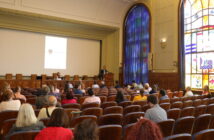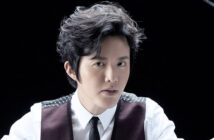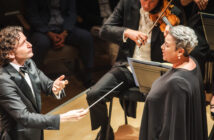
This page is also available in / Cette page est également disponible en:
![]() Francais (French)
Francais (French)
At first glance, the premise may sound simple: one concert, four violin concertos. The seasoned classical concert-goer, however, will understand just how ambitious an endeavour this is, and that this sort of programming is practically unheard of. Who would do such a thing?
Alex Pauk, of course—the same person who was told that a full-sized orchestra devoted to the performance of contemporary music was never going to survive for longer than a year, and who has been conducting that very orchestra for 40.
On Nov. 27, Esprit Orchestra will present its second concert of the ambitious 40th anniversary season, Violinissimo. The concert will feature José Evangelista’s piece of the same name, Figures hâtives by John Rea and the world première of Andrew Staniland’s Six Enigmas. The presentation of these works will culminate in a performance of Alexina Louie’s inimitable Triple Concerto for Three Violins and Orchestra, first premièred in 2017. These impressive works are to be interpreted by equally impressive musicians, all concertmasters of major Toronto orchestras: Aaron Schwebel of the National Ballet of Canada Orchestra; Marie Bérard of the Canadian Opera Company Orchestra; and Stephen Sitarski, Esprit’s own.
Sitarski has been a part of Esprit since nearly the beginning. He was completing his studies when the orchestra was first looking for players, and joined briefly in its first year—decades (and many appointments) later, he returned to Esprit in 2011, and has served as concertmaster ever since. He is drawn to contemporary music for the way it allows orchestral configurations to demonstrate their adaptability, and get at the “chaotic and complicated nature of our world.” Staniland’s Six Enigmas was written for Sitarski, this being the third concerto created for him. Following a highly collaborative process between Staniland and Sitarski, the piece was completed this summer. Sitarski praises Staniland’s composition for the way it highlights both the former’s soloistic voice, and the latter’s compositional one. The pair will bring it to life for the first time in the rehearsal room, and invite the public into their sound world Nov. 27.
Similarly to Sitarski, Marie Bérard, current concertmaster of the Canadian Opera Company Orchestra, has a long history with Esprit, dating back to the orchestra’s early years—in fact, she was member of the National Youth Orchestra in 1981, when Alex Pauk first conceived of the group. She was a part of the orchestra for its first concert, played as concertmaster for many years and, after a hiatus, has delighted in her return. “It’s a great bunch of people,” she says. “The music is always new, and challenging, for everyone—and Alex’s enthusiasm is infectious.” Bérard will perform John Rea’s Figures hâtives in the November concert, a piece she has played before. Programming contemporary works more than once is a part of Esprit’s mission, as the orchestra aims to give meaningful life to new works, and to support the development of musical language and style through a piece’s evolution. Bérard describes it as a “very well-built piece,” constantly building in momentum, carefully conceived for the violin, and featuring fascinating harmonic and melodic language.
Unlike his colleagues, this will be Aaron Schwebel’s first performance with Esprit. A longtime admirer of the orchestra, Schwebel notes that he has been impressed by Esprit’s work for many years, and has deep admiration for its programming, as well as the high level of commitment its members bring to challenging repertoire, time and time again. “It is an honour,” he says, “to have been invited to join Marie and Steve” for Violinissimo. Schwebel will play José Evangelista’s concerto of the same name—a thrilling three-movement concerto that brings together classical forms, historical instruments, and new sonic palettes. Acrobatic and athletic in some moments and meditative in others, the piece brings a whole new life to the traditional concerto form. “It really shows off the violin, as the name suggests,” says Schwebel.
Schwebel, Bérard, and Sitarski will join forces for the fourth concerto on the program: Alexina Louie’s Triple Concerto for Three Violins and Orchestra. Schwebel, who has experience with Louie’s chamber repertoire, makes note of the way this piece combines soloistic elements, and a real sense of ensemble—both between the orchestra and the soloists, and the soloists themselves. “We will find our way together,” he says, as the piece involves passing melodic and rhythmic material between them.
“The three of us will have to agree on points of style and gesture,” Bérard expands, although it does not sound like she thinks this will represent a challenge. “I love Steve and Aaron,” she says. Sitarski cites the advantage the group will have in being able to study the 2017 recording of the piece. “As musicians, we gain so much information through listening,” he points out. Triple Concerto is highly virtuosic and altogether unique: “I don’t know if another piece exists like it,” says Bérard.
Four highly complex and exciting musical works, three incredible soloists, and one fearless conductor and orchestra will join forces to bring Violinissimo to life. Although contemporary music can sometimes intimidate audiences, “it’s just music,” says Bérard. “It is our job to draw audiences in ( and) even when the language isn’t familiar, to communicate as storytellers.”
“When we open our ears, it can be magic,” she says.
Esprit—with Sitarski, Bérard and Schwebel—will comb through their respective pieces to find “structure, story and gesture,” bringing out the “characters” in these works by Louie, Evangelista, Rea, and Staniland at Koerner Hall on Nov. 27.
This page is also available in / Cette page est également disponible en:
![]() Francais (French)
Francais (French)














